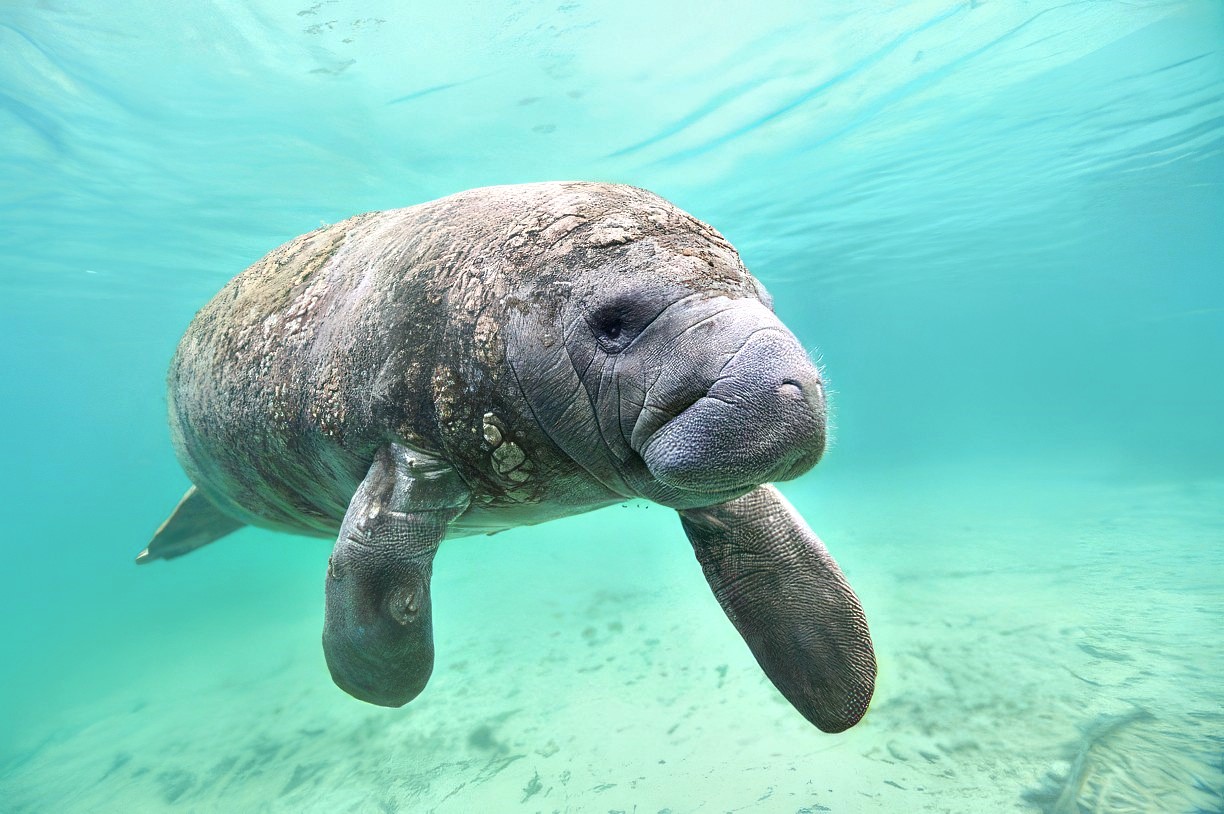🐮 The Gentle Ocean Grazers
In the vast expanse of the ocean, there exists a group of gentle creatures known as sea cows and dugongs. These marine mammals have captured the imagination of sailors and coastal communities for centuries, their peaceful demeanor and peculiar appearance fueling legends of mermaids and sea nymphs. 🌺
Sea cows, belonging to the Trichechidae family, and dugongs, from the Dugongidae family, are herbivorous cousins that graze on seagrass beds and aquatic vegetation. Despite their shared ancestry with elephants, which diverged millions of years ago, their forms have evolved to suit life in the ocean, shedding the distinctive features of their land-dwelling relatives. 🐘🌊
While sea cows boast a more rounded, robust body, dugongs possess a sleek, streamlined physique adorned with a dolphin-like tail fluke. Both species sport small eyes, nostrils with valves to prevent water entry, and lack protruding ears or a prominent snout, lending them an endearingly alien appearance. 👁️🐽
🔍 The Legendary Sightings
One of the most famous accounts of mistaking these creatures for mermaids came from none other than Christopher Columbus himself. In 1493, during his voyage to the New World, Columbus claimed to have spotted three mermaids near the island of Haiti, which coincidentally is a known habitat for sea cows. 🚢⛵
His description, while acknowledging their lack of beauty compared to the mythical tales, noted their human-like appearance. “Although they were not as beautiful as they are represented, in some measure they have the form of a human face,” he wrote, fueling the imagination of his crew and future explorers. 🧜♀️
This perception can be attributed to two key factors:
- 🧜♀️ The graceful manner in which dugongs and sea cows surface to breathe, with their bodies appearing to stand upright in the water, resembling the mermaid posture portrayed in folklore.
- 💃 The presence of mammary glands near the front flippers, resembling the positioning of human breasts, further reinforced the human-like appearance when nursing their young calves.
🌍 Global Legends and Folklore
It wasn’t just Western cultures that associated these marine mammals with mythical beings. Throughout the world, diverse communities have incorporated dugongs and sea cows into their folklore and legends, weaving them into tales of the sea’s mysteries. 🌊🧜♂️
- 🌺 In Southeast Asian traditions, they were often depicted as human or half-human female figures, with the upper body of a woman and the lower body of a fish or sea creature.
- 👸 In Kenyan culture, dugongs were known as the “Queen of the Sea,” further solidifying their association with feminine aquatic entities and the mystical allure of the ocean depths.
- 🧚♀️ Even in regions without direct exposure to these creatures, tales of mermen, mermaids, and merfolk existed, reflecting the universal allure of the unknown depths and the human fascination with the sea’s enigmatic inhabitants.
🍃 Gentle Grazers and Ecosystem Guardians
Despite their fearsome appearance to some, dugongs and sea cows are entirely herbivorous, grazing on seagrass beds and aquatic vegetation. Their dietary habits have earned them the nickname “sea grass lawnmowers,” as they meticulously graze on the underwater meadows, leaving trails of cropped vegetation in their wake. 🍃🌿
However, far from being destructive, these gentle grazers play a crucial role in maintaining the health and biodiversity of seagrass ecosystems. Recent studies by researchers like Dr. Samantha Tol from James Cook University have revealed the intricate relationship between these creatures and the seagrass beds they inhabit. 🔬
By analyzing the fecal matter of dugongs and green sea turtles, another significant seagrass consumer, Tol and her team discovered an abundance of seagrass seeds. On average, each sample contained one to two seeds, with those passed through the digestive systems of these marine herbivores exhibiting a four-fold increase in germination rates and a 60% faster germination speed compared to naturally dispersed seeds. 🌱
Moreover, the extended digestive process of dugongs and sea cows, which can take up to six or seven days due to the length of their intestines (up to 40 meters!), allows for the dispersal of seeds over vast distances, up to 650 kilometers away from the initial seagrass bed. This seed dispersal mechanism plays a vital role in the expansion and regeneration of these underwater meadows. 🌳
🚨 Threats and Conservation Efforts
Sadly, these gentle marine mammals face numerous threats, both natural and human-caused, jeopardizing their continued existence. While their natural predators include killer whales, sharks, and saltwater crocodiles, the primary threats stem from habitat degradation, pollution, and boat strikes. 🦈⚓️🐊
Coastal development, storm surges, and rising water temperatures can devastate the fragile seagrass beds upon which they rely for sustenance and shelter. Additionally, discarded fishing nets, plastic pollution, and propeller strikes from boats pose significant risks, often resulting in injury, entanglement, or death. 🚢⚔️🌍
Conservation efforts aim to protect these creatures and their vital ecosystems through a multifaceted approach. Habitat preservation, marine protected areas, and restoration of degraded seagrass beds are crucial steps in safeguarding their future. Awareness campaigns and educational initiatives also play a pivotal role in fostering appreciation for these gentle giants and their ecological importance. 🌱
Furthermore, addressing the human-caused threats, such as reducing plastic pollution, promoting responsible boating practices, and implementing sustainable coastal development policies, can significantly mitigate the impact on these vulnerable populations. 🛥️♻️
By safeguarding these gentle ocean grazers, we not only preserve their unique place in the web of life but also protect the delicate balance of the marine environments they call home. The health of seagrass ecosystems is inextricably linked to the well-being of countless other species, making the conservation of dugongs and sea cows a crucial endeavor for the overall preservation of ocean biodiversity. 🌊🌍🐟
Copyright © 2025 Hea1th.net

